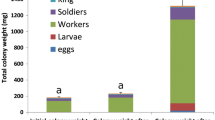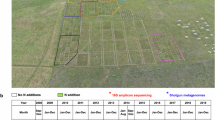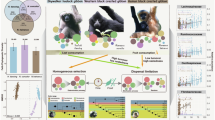Abstract
Although it is well documented that the lack of nitrogen in the diet of wood-feeding termites is compensated by the nitrogen-fixing capacity of their gut microbiota, the bacteria responsible for this activity are largely unknown. Here, we analyzed the diversity and expression of nitrogenase genes (homologs of nifH) in four species of dry-wood termites (Kalotermitidae), which thrive on a particularly nitrogen-poor resource. Although each species harbored a highly diverse suite of termite-specific homologs in their microliter-sized hindgut, only a core set related to nifH genes of Treponema and Azoarcus spp., ‘Azobacteroides pseudotrichonymphae’, the first member of the Bacteroidales identified as a diazotroph, and termite-gut-specific anfH genes of hitherto unknown origin were preferentially expressed. Transcription patterns corroborated that the populations of active diazotrophs differ fundamentally between termite genera. Capillary-picked suspensions of the flagellates Devescovina arta and Snyderella tabogae revealed that their bacterial ectosymbionts each possess two paralogs of nifH, which apparently have been acquired consecutively during evolution of Bacteroidales, but only one of them (anfH) is actively expressed. Transcription patterns correlated neither with the molybdenum content of the diet nor with intestinal hydrogen concentrations, measured with microsensors. We propose that the nitrogen-fixing community in different dry-wood termites is shaped by the symbionts of their specific flagellate populations. Our findings suggest that the diazotrophic nature of ‘Armantifilum devescovinae’ has an important role in the nitrogen metabolism of dry-wood termites and is the driving force of co-evolution with its flagellate host.
Similar content being viewed by others
Log in or create a free account to read this content
Gain free access to this article, as well as selected content from this journal and more on nature.com
or
Accession codes
References
Benemann JR . (1973). Nitrogen fixation in termites. Science 181: 164–165.
Braun S, Proctor L, Zani S, Mellon MT, Zehr JP . (1999). Molecular evidence for zooplankton-associated nitrogen-fixing anaerobes based on amplification of the nifH gene. FEMS Microbiol Ecol 28: 273–279.
Breznak JA, Brill WJ, Mertins JW, Coppel HC . (1973). Nitrogen fixation in termites. Nature 244: 577–580.
Breznak JA . (2000). Ecology of prokaryotic microbes in the guts of wood- and litter-feeding termites. In: Abe T, Bignell DE, Higashi M (eds). Termites: Evolution, Sociality, Symbiosis, Ecology. Kluwer Academic Publishers: Dordrecht, pp 209–231.
Brune A, Ohkuma M . (2011). Role of the termite gut microbiota in symbiotic digestion. In: Bignell DE, Roisin Y, Lo N (eds). Biology of Termites: a Modern Synthesis. Springer: Heidelberg, pp 439–475.
Brune A, Stingl U . (2005). Prokaryotic symbionts of termite gut flagellates: phylogenetic and metabolic implications of a tripartite symbiosis. In: Overmann J (ed). Molecular Basis of Symbiosis. Springer-Verlag: Berlin, pp 39–60.
Brune A . (2006). Symbiotic associations between termites and prokaryotes. In: Dworkin M, Falkow S, Rosenberg E, Schleifer K-H, Stackebrandt E (eds). The Prokaryotes Symbiotic Associations, Biotechnology, Applied Microbiology, 3rd edn, Vol. 1 Springer: New York, pp 439–474.
Cleveland LR . (1925). The ability of termites to live perhaps indefinitely on a diet of pure cellulose. Biol Bull 48: 289–293.
Dean DR, Jacobson MR . (1992). Biochemical genetics of nitrogenase. In: Stacy G, Burris RH, Evans HJ (eds). Biological Nitrogen Fixation. Chapman and Hall: New York, pp 763–834.
Desai MS, Strassert JFH, Meuser K, Hertel H, Ikeda-Ohtsubo W, Radek R, Brune A . (2010). Strict cospeciation of devescovinid flagellates and Bacteroidales ectosymbionts in the gut of dry-wood termites (Kalotermitidae). Environ Microbiol 12: 2120–2132.
Eady RR . (1996). Structure–function relationships of alternative nitrogenases. Chem Rev 96: 3013–3030.
Ebert A, Brune A . (1997). Hydrogen concentration profiles at the oxic–anoxic interface: a microsensor study of the hindgut of the wood-feeding lower termite Reticulitermes flavipes (Kollar). Appl Environ Microbiol 63: 4039–4046.
Graber JR, Leadbetter JR, Breznak JA . (2004). Description of Treponema azotonutricium sp. nov. and Treponema primitia sp. nov., the first spirochetes isolated from termite guts. Appl Environ Microbiol 70: 1315–1320.
Guth JH, Burris RH . (1983). Inhibition of nitrogenase-catalyzed NH3 formation by H2 . Biochemistry 22: 5111–5122.
Hardy RWF, Burns RC, Holsten RD . (1973). Applications of the acetylene–ethylene assay for measurement of nitrogen fixation. Soil Biol Biochem 5: 47–81.
Henckel T, Friedrich M, Conrad R . (1999). Molecular analyses of the methane-oxidizing microbial community in rice field soil by targeting the genes of the 16S rRNA, particulate methane monooxygenase, and methanol dehydrogenase. Appl Environ Microbiol 65: 1980–1990.
Hongoh Y, Ohkuma M . (2010). Termite gut flagellates and their methanogenic and eubacterial symbionts. In: Hackstein, JHP (ed). (Endo)symbiotic Methanogenic Archaea. Springer: Heidelberg, pp 55–79.
Hongoh Y, Sharma VK, Prakash T, Noda S, Taylor TD, Kudo T et al. (2008a). Complete genome of the uncultured Termite Group 1 bacteria in a single host protist cell. Proc Natl Acad Sci USA 105: 5555–5560.
Hongoh Y, Sharma VK, Prakash T, Noda S, Toh H, Taylor TD et al. (2008b). Genome of an endosymbiont coupling N2 fixation to cellulolysis within protist cells in termite gut. Science 322: 1108–1199.
Hurek T, Reinhold-Hurek B . (2003). Azoarcus sp. strain BH72 as a model for nitrogen-fixing grass endophytes. J Biotechnol 106: 169–178.
Ikeda-Ohtsubo W, Brune A . (2009). Cospeciation of termite gut flagellates and their bacterial endosymbionts: Trichonympha species and ‘Candidatus Endomicrobium trichonymphae’. Mol Ecol 18: 332–342.
Ikeda-Ohtsubo W, Desai M, Stingl U, Brune A . (2007). Phylogenetic diversity of Endomicrobia and their specific affiliation with termite gut flagellates. Microbiology 153: 3458–3465.
Inoue J-I, Saita K, Kudo T, Ui S, Ohkuma M . (2007). Hydrogen production by termite-gut protists: characterization of iron hydrogenases of parabasalian symbionts of the termite Coptotermes formosanus. Eukaryot Cell 6: 1925–1932.
Kessler PS, McLarnan J, Leigh JA . (1997). Nitrogenase phylogeny and the molybdenum dependence of nitrogen fixation in Methanococcus maripaludis. J Bacteriol 179: 541–543.
Lilburn TG, Kim KS, Ostrom NE, Byzek KR, Leadbetter JR, Breznak JA . (2001). Nitrogen fixation by symbiotic and free-living spirochetes. Science 292: 2495–2498.
Lueders T, Manefield M, Friedrich MW . (2004). Enhanced sensitivity of DNA- and rRNA-based stable isotope probing by fractionation and quantitative analysis of isopycnic centrifugation gradients. Environ Microbiol 6: 73–78.
Masepohl B, Klipp W . (1996). Organization and regulation of genes encoding the molybdenum nitrogenase and the alternative nitrogenase in Rhodobacter capsulatus. Arch Microbiol 165: 80–90.
Messer AC, Lee MJ . (1989). Effect of chemical treatments on methane emission by the hindgut microbiota in the termite Zootermopsis angusticollis. Microb Ecol 18: 275–284.
Noda S, Hongoh Y, Sato T, Ohkuma M . (2009). Complex coevolutionary history of symbiotic Bacteroidales bacteria of various protists in the gut of termites. BMC Evol Biol 9: 158.
Noda S, Inoue T, Hongoh Y, Kawai M, Nalepa CA, Vongkaluang C et al. (2006). Identification and characterization of ectosymbionts of distinct lineages in Bacteroidales attached to flagellated protists in the gut of termites and a wood-feeding cockroach. Environ Microbiol 8: 11–20.
Noda S, Kitade O, Inoue T, Kawai M, Kanuka M, Hiroshima K et al. (2007). Cospeciation in the triplex symbiosis of termite gut protists (Pseudotrichonympha spp.), their hosts, and their bacterial endosymbionts. Mol Ecol 16: 1257–1266.
Noda S, Ohkuma M, Kudo T . (2002). Nitrogen fixation genes expressed in the symbiotic microbial community in the gut of the termite Coptotermes formosanus. Microbes Environ 17: 139–143.
Noda S, Ohkuma M, Usami R, Horikoshi K, Kudo T . (1999). Culture-independent characterization of a gene responsible for nitrogen fixation in the symbiotic microbial community in the gut of the termite Neotermes koshunensis. Appl Environ Microbiol 65: 4935–4942.
Noda S, Ohkuma M, Yamada A, Hongoh Y, Kudo T . (2003). Phylogenetic position and in situ identification of ectosymbiotic spirochetes on protists in the termite gut. Appl Environ Microbiol 69: 625–633.
Ohkuma M, Brune A . (2011). Diversity, structure, and evolution of the termite gut microbial community. In: Bignell DE, Roisin Y, Lo N (eds). Biology of Termites: a Modern Synthesis. Springer: Dordrecht, pp. 413–438.
Ohkuma M, Noda S, Usami K, Horikoshi, Kudo T . (1996). Diversity of nitrogen fixation genes in the symbiotic intestinal microflora of the termite Reticulitermes speratus. Appl Environ Microbiol 62: 2747–2752.
Ohkuma M, Noda S, Hongoh Y, Kudo T . (2002). Diverse bacteria related to the Bacteroides subgroup of the CFB phylum within the gut symbiotic communities of various termites. Biosci Biotechnol Biochem 66: 78–84.
Ohkuma M, Noda S, Kudo T . (1999). Phylogenetic diversity of nitrogen fixation genes in the symbiotic microbial community in the gut of diverse termites. Appl Environ Microbiol 65: 4926–4934.
Ohkuma M, Sato T, Noda S, Ui S, Kudo T, Hongoh Y . (2007). The candidate phylum ‘Termite Group 1’ of bacteria: phylogenetic diversity, distribution, and endosymbiont members of various gut flagellated protists. FEMS Microbiol Ecol 60: 467–476.
Pester M, Brune A . (2006). Expression profiles of fhs (FTHFS) genes support the hypothesis that spirochaetes dominate reductive acetogenesis in the hindgut of lower termites. Environ Microbiol 8: 1261–1270.
Pester M, Brune A . (2007). Hydrogen is the central free intermediate during lignocellulose degradation by termite gut symbionts. ISME J 1: 551–565.
Sicking C, Brusch M, Lindackers A, Riedel K-U, Schubert B, Isakovic N et al. (2005). Identification of two new genes involved in diazotrophic growth via the alternative Fe-only nitrogenase in the phototrophic purple bacterium Rhodobacter capsulatus. J Bacteriol 187: 92–98.
Stingl U, Radek R, Yang H, Brune A . (2005). ‘Endomicrobia’: cytoplasmic symbionts of termite gut protozoa form a separate phylum of prokaryotes. Appl Environ Microbiol 71: 1473–1479.
Strassert JFH, Desai MS, Brune A, Radek R . (2009). The true diversity of devescovinid flagellates in the termite Incisitermes marginipennis. Protist 160: 522–535.
Strassert JFH, Desai MS, Radek R, Brune A . (2010). Identification and localization of multiple bacterial symbionts in the termite gut flagellate Joenia annectens. Microbiology 156: 2068–2079.
Tayasu I, Inoue T, Miller LR, Sugimoto A, Takeichi S, Abe T . (1998). Confirmation of soil-feeding termites (Isoptera; Termitidae; Termitinae) in Australia using stable isotope ratios. Funct Ecol 12: 536–542.
Warnecke F, Luginbühl P, Ivanova N, Ghassemian M, Richardson TH, Stege JT et al. (2007). Metagenomic and functional analysis of hindgut microbiota of a wood-feeding higher termite. Nature 450: 560–565.
Yamada A, Inoue T, Noda S, Hongoh Y, Ohkuma M . (2007). Evolutionary trend of phylogenetic diversity of nitrogen fixation genes in the gut community of wood-feeding termites. Mol Ecol 16: 3768–3777.
Yamin MA . (1979). Flagellates of the orders Trichomonadida Kirby, Oxymonadida Grassé, and Hypermastigida Grassi and Foà reported from lower termites (Isoptera families Mastotermitidae, Kalotermitidae, Hodotermitidae, Termopsidae, Rhinotermitidae, and Serritermitidae) and from the wood-feeding roach Cryptocercus (Dictyoptera: Cryptocercidae). Sociobiology 4: 1–119.
Zehr JP, Jenkins BD, Short SM, Steward GF . (2003). Nitrogenase gene diversity and microbial community structure: a cross-system comparison. Environ Microbiol 5: 539–554.
Acknowledgements
Mahesh S Desai received a doctoral fellowship from the International Max Planck Research School for Environmental, Cellular, and Molecular Microbiology. We are grateful to Rüdiger Plarre and Horst Hertel for providing termites, and Katja Meuser for technical assistance. We also thank Michael Pester and David K Ngugi for help with microsensor and GC measurements, Tim Köhler for sharing unpublished results, and Karen A Brune for comments on the manuscript.
Author information
Authors and Affiliations
Corresponding author
Ethics declarations
Competing interests
The authors declare no conflict of interest.
Rights and permissions
About this article
Cite this article
Desai, M., Brune, A. Bacteroidales ectosymbionts of gut flagellates shape the nitrogen-fixing community in dry-wood termites. ISME J 6, 1302–1313 (2012). https://doi.org/10.1038/ismej.2011.194
Received:
Revised:
Accepted:
Published:
Issue date:
DOI: https://doi.org/10.1038/ismej.2011.194
Keywords
This article is cited by
-
Nitrogen Fixation and Diazotrophic Community in Plastic-Eating Mealworms Tenebrio molitor L
Microbial Ecology (2023)
-
The functional evolution of termite gut microbiota
Microbiome (2022)
-
Quantification of biological nitrogen fixation by Mo-independent complementary nitrogenases in environmental samples with low nitrogen fixation activity
Scientific Reports (2022)
-
Soil organic matter is essential for colony growth in subterranean termites
Scientific Reports (2021)
-
Characterization of Bacterial Communities Associated with Rhynchophorus ferrugineus Olivier (Coleoptera: Curculionidae) and its Host Phoenix sylvestris
Current Microbiology (2020)



